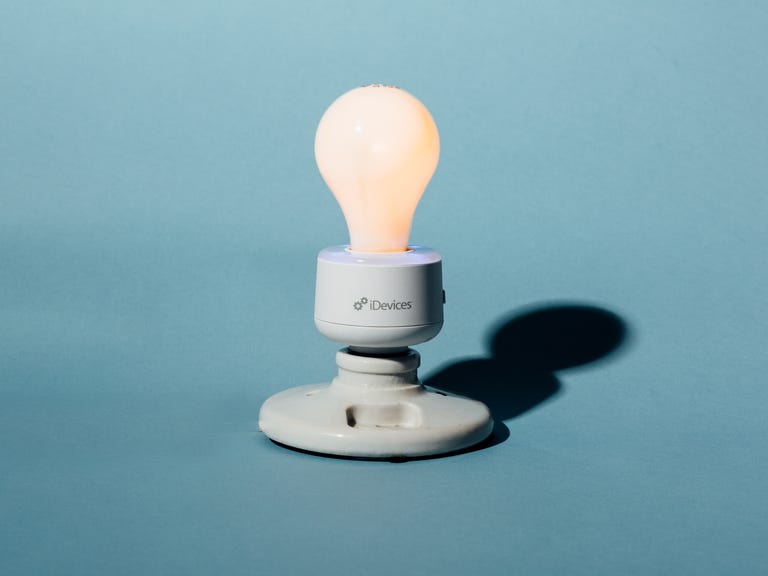 Why You Can Trust CNET
Why You Can Trust CNET iDevices Socket review: The iDevices Socket performs well enough, but why use it?
The iDevices Socket can dim, schedule and voice-control lights. But so can everything else, for less.
Lighting is one of the easiest and most affordable entry points into smart-home gadgetry. Connected LEDs, switches and plugs typically slide in around or under 50 bucks. But now a new type of device is available -- a retrofit Socket that lends smarts to any bulb screwed into it. Sure, crowdsourcing hopefuls have proposed similar products in the past, but this is different. iDevices is an established company, and the Socket integrates with Apple HomeKit and Amazon Echo.
The Good
The Bad
The Bottom Line
On its surface, the Socket functions as advertised: it smartens up almost any standard bulb, adding dimming, scheduling and voice-activated controls with both Apple's Siri and Amazon's Alexa. It even includes an RGB color changing nightlight. But there's a fundamental question I've been unable to answer: When is the Socket consistently more useful than a smart switch or bulb? The $80 price tag only adds to my befuddlement, since you can easily find more feature-rich lighting devices for considerably less cash.
Until I find a unique use case that justifies the Socket's otherwise outrageous asking price, I can't recommend iDevices' newest product.
What it gets right
Taken as it is, the Socket actually works pretty well. The iDevices app has always been one of the better third party HomeKit apps out there, and it continues to support its devices with an intuitive interface and easy setup process. Getting the Socket up and running takes barely a minute, and operating its dimming, scheduling, and nightlight capabilities is slick the whole time.
The iDevices app also connects to the Socket using both Bluetooth and Wi-Fi, so the connection is reliable whether you're home or away.
What it gets wrong
The big problem with the iDevices Socket is that it doesn't fulfill any particular customer need. If you want a bulb that can dim and schedule, buy a smart LED -- you'll get more lighting features than the Socket. If you want to keep your current retro bulbs, but also want smart features, buy a smart switch or plug -- you'll avoid the strange look of old bulbs hanging from a white plastic device.
I asked the developers at iDevices what exactly distinguishes the Socket from other devices on the market, and they responded with two primary features: it's easy to install (meaning it doesn't require a hub), and it works with Apple HomeKit (meaning you can control it remotely and using Siri).
Lighting device feature comparison
| Moveable | Lamps | Fixtures | HomeKit | Amazon Echo | Dimming | Scheduling | RGB or White-Light color changing | Price | Hub required | Installation | |
| iDevices Socket | Yes | Sometimes | Yes | Yes | Yes | Yes | Yes | No | $80 | No | Quick |
| Philips Hue White | Yes | Yes | Yes | Yes | Yes | Yes | Yes | No | $15 | Yes - $60 | Quick plus hub |
| Philips Hue White and Color Ambience | Yes | Yes | Yes | Yes | Yes | Yes | Yes | Yes | $60 | Yes - $60 | Quick plus hub |
| Lifx Color 1000 LED | Yes | Yes | Yes | No | Yes | Yes | Yes | Yes | $60 | No | Quick |
| Belkin WeMo In-Wall Switch | No | Sometimes | Yes | No | Yes | No | Yes | No | $50 | No | Slow |
| iDevices Switch (smart plug) | Yes | Yes | No | Yes | Yes | No | Yes | No | $50 | No | Quick |
| Lifx White 800 LED | Yes | Yes | Yes | No | Yes | Yes | Yes | White-light only | $30 | No | Quick |
| Lutron Caseta In-Wall Dimmer | No | Sometimes | Yes | Yes | Yes | Yes | Yes | No | $55 | Yes - $80 | Slow |
But look at the Socket versus the Philips Hue White bulbs on the chart above. They're almost identical. Sure, Philips Hue bulbs require a hub, but that added cost and hassle stops looking so bad when each light bulb afterward costs only $15 -- $65 less than a single Socket.
Across the chart above, you can see that, yes, the iDevices Socket has a unique feature set. But that doesn't make it a unique product. Plenty of devices do scheduling and let you keep your original bulbs. Plenty do dimming, work with HomeKit or do hubless setup. If you need this exact combination of features, and you almost certainly don't, then you should consider the iDevices Socket.
But for most consumers, finding a gadget that offers a marginally different feature-set isn't worth 80 bucks.


